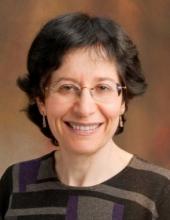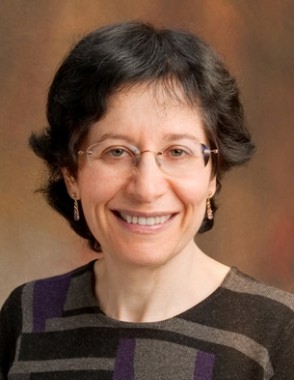User login
MINNEAPOLIS – Caffeine therapy for apnea of prematurity did not prevent the development of persistent and significant obstructive apnea in children by the time they were 9 years old.
"Apnea of prematurity occurs in more than three-quarters of infants born at under 30 weeks’ gestation, and more than half of these apneas are actually obstructive in nature," Dr. Carole Marcus, director of the sleep center at Children’s Hospital of Philadelphia, said at the annual meeting of the Associated Professional Sleep Societies. "Caffeine is now the most commonly used drug [to treat apnea of prematurity] in the NICU in infants less than 32 weeks’ gestation," she said.
The long-term effects of caffeine on sleep in the developing brain are not well understood. It is not known whether neonatal caffeine administration has permanent adverse effects on sleep architecture and ventilatory control, perhaps increasing the risk of later sleep disorders such as insomnia and obstructive sleep apnea (OSA).
In the earlier CAP (Caffeine for Apnea of Prematurity) trial, 793 premature infants with birth weights of 500-1250 g were randomly assigned to caffeine or placebo until therapy for apnea of prematurity was no longer needed. Caffeine significantly improved the rate of survival without neurodevelopmental disability at 18-21 months in these babies versus placebo (N. Engl. J. Med. 2007;357:1893-902).
The subsequent axillary long-term CAP-S (Sleep) trial of 201 CAP subjects looked at whether neonatal caffeine administration resulted in later sleep abnormalities. The researchers assessed the ex-premature children aged 5-11 years (mean age, 9 years) via sleep questionnaires, actigraphy, and full ambulatory (home-based) polysomnography. The patients assessed in CAP-S were from Canada or Australia, with a high proportion of white patients, high maternal education, and high socioeconomic status, "which is relevant to our obstructive sleep apnea outcomes," noted Dr. Marcus.
No significant differences were noted in children who had received caffeine, compared with those who did not, in terms of subjective measures of sleep quality or quantity. Total recording time and total sleep time on polysomnography were somewhat longer in the caffeine arm, but there was no difference seen in sleep efficiency between groups (P = .91).
However, OSA (apnea-hypopnea index of more than two episodes per hour) was common in both groups (8.2% of the caffeine group and 11% of the placebo group; P = .22). In contrast, the prevalence of OSA in the general pediatric population is 1%-4%.
Also, 24% of the caffeine group and 29% of the placebo group had OSA on polysomnography and/or a history of adenoidectomy/tonsillectomy, again with no difference between groups (P = .35).
A large proportion of subjects in both arms had elevated periodic limb movements (17.5% in the caffeine group and 11% in the placebo groups; P = .27), a proportion that was markedly higher than was the normal prevalence in cases in which the child had more than five episodes of periodic limb movement per hour, which lies between 5% and 8%."This study further supports the use of caffeine for apnea of prematurity as it has been shown to have quite a number of beneficial effects and no long-term adverse effects," said Dr. Marcus. "Further study is needed on the mechanisms underlying the high prevalence of sleep disorders, both OSA and [periodic limb movement syndrome], in ex-preterm infants."
Dr. Marcus said there is a long-term behavioral and neurocognitive outcomes study ongoing on the CAP cohort, but they were unable to combine those results with the sleep study results because the data were collected too far apart.
MINNEAPOLIS – Caffeine therapy for apnea of prematurity did not prevent the development of persistent and significant obstructive apnea in children by the time they were 9 years old.
"Apnea of prematurity occurs in more than three-quarters of infants born at under 30 weeks’ gestation, and more than half of these apneas are actually obstructive in nature," Dr. Carole Marcus, director of the sleep center at Children’s Hospital of Philadelphia, said at the annual meeting of the Associated Professional Sleep Societies. "Caffeine is now the most commonly used drug [to treat apnea of prematurity] in the NICU in infants less than 32 weeks’ gestation," she said.
The long-term effects of caffeine on sleep in the developing brain are not well understood. It is not known whether neonatal caffeine administration has permanent adverse effects on sleep architecture and ventilatory control, perhaps increasing the risk of later sleep disorders such as insomnia and obstructive sleep apnea (OSA).
In the earlier CAP (Caffeine for Apnea of Prematurity) trial, 793 premature infants with birth weights of 500-1250 g were randomly assigned to caffeine or placebo until therapy for apnea of prematurity was no longer needed. Caffeine significantly improved the rate of survival without neurodevelopmental disability at 18-21 months in these babies versus placebo (N. Engl. J. Med. 2007;357:1893-902).
The subsequent axillary long-term CAP-S (Sleep) trial of 201 CAP subjects looked at whether neonatal caffeine administration resulted in later sleep abnormalities. The researchers assessed the ex-premature children aged 5-11 years (mean age, 9 years) via sleep questionnaires, actigraphy, and full ambulatory (home-based) polysomnography. The patients assessed in CAP-S were from Canada or Australia, with a high proportion of white patients, high maternal education, and high socioeconomic status, "which is relevant to our obstructive sleep apnea outcomes," noted Dr. Marcus.
No significant differences were noted in children who had received caffeine, compared with those who did not, in terms of subjective measures of sleep quality or quantity. Total recording time and total sleep time on polysomnography were somewhat longer in the caffeine arm, but there was no difference seen in sleep efficiency between groups (P = .91).
However, OSA (apnea-hypopnea index of more than two episodes per hour) was common in both groups (8.2% of the caffeine group and 11% of the placebo group; P = .22). In contrast, the prevalence of OSA in the general pediatric population is 1%-4%.
Also, 24% of the caffeine group and 29% of the placebo group had OSA on polysomnography and/or a history of adenoidectomy/tonsillectomy, again with no difference between groups (P = .35).
A large proportion of subjects in both arms had elevated periodic limb movements (17.5% in the caffeine group and 11% in the placebo groups; P = .27), a proportion that was markedly higher than was the normal prevalence in cases in which the child had more than five episodes of periodic limb movement per hour, which lies between 5% and 8%."This study further supports the use of caffeine for apnea of prematurity as it has been shown to have quite a number of beneficial effects and no long-term adverse effects," said Dr. Marcus. "Further study is needed on the mechanisms underlying the high prevalence of sleep disorders, both OSA and [periodic limb movement syndrome], in ex-preterm infants."
Dr. Marcus said there is a long-term behavioral and neurocognitive outcomes study ongoing on the CAP cohort, but they were unable to combine those results with the sleep study results because the data were collected too far apart.
MINNEAPOLIS – Caffeine therapy for apnea of prematurity did not prevent the development of persistent and significant obstructive apnea in children by the time they were 9 years old.
"Apnea of prematurity occurs in more than three-quarters of infants born at under 30 weeks’ gestation, and more than half of these apneas are actually obstructive in nature," Dr. Carole Marcus, director of the sleep center at Children’s Hospital of Philadelphia, said at the annual meeting of the Associated Professional Sleep Societies. "Caffeine is now the most commonly used drug [to treat apnea of prematurity] in the NICU in infants less than 32 weeks’ gestation," she said.
The long-term effects of caffeine on sleep in the developing brain are not well understood. It is not known whether neonatal caffeine administration has permanent adverse effects on sleep architecture and ventilatory control, perhaps increasing the risk of later sleep disorders such as insomnia and obstructive sleep apnea (OSA).
In the earlier CAP (Caffeine for Apnea of Prematurity) trial, 793 premature infants with birth weights of 500-1250 g were randomly assigned to caffeine or placebo until therapy for apnea of prematurity was no longer needed. Caffeine significantly improved the rate of survival without neurodevelopmental disability at 18-21 months in these babies versus placebo (N. Engl. J. Med. 2007;357:1893-902).
The subsequent axillary long-term CAP-S (Sleep) trial of 201 CAP subjects looked at whether neonatal caffeine administration resulted in later sleep abnormalities. The researchers assessed the ex-premature children aged 5-11 years (mean age, 9 years) via sleep questionnaires, actigraphy, and full ambulatory (home-based) polysomnography. The patients assessed in CAP-S were from Canada or Australia, with a high proportion of white patients, high maternal education, and high socioeconomic status, "which is relevant to our obstructive sleep apnea outcomes," noted Dr. Marcus.
No significant differences were noted in children who had received caffeine, compared with those who did not, in terms of subjective measures of sleep quality or quantity. Total recording time and total sleep time on polysomnography were somewhat longer in the caffeine arm, but there was no difference seen in sleep efficiency between groups (P = .91).
However, OSA (apnea-hypopnea index of more than two episodes per hour) was common in both groups (8.2% of the caffeine group and 11% of the placebo group; P = .22). In contrast, the prevalence of OSA in the general pediatric population is 1%-4%.
Also, 24% of the caffeine group and 29% of the placebo group had OSA on polysomnography and/or a history of adenoidectomy/tonsillectomy, again with no difference between groups (P = .35).
A large proportion of subjects in both arms had elevated periodic limb movements (17.5% in the caffeine group and 11% in the placebo groups; P = .27), a proportion that was markedly higher than was the normal prevalence in cases in which the child had more than five episodes of periodic limb movement per hour, which lies between 5% and 8%."This study further supports the use of caffeine for apnea of prematurity as it has been shown to have quite a number of beneficial effects and no long-term adverse effects," said Dr. Marcus. "Further study is needed on the mechanisms underlying the high prevalence of sleep disorders, both OSA and [periodic limb movement syndrome], in ex-preterm infants."
Dr. Marcus said there is a long-term behavioral and neurocognitive outcomes study ongoing on the CAP cohort, but they were unable to combine those results with the sleep study results because the data were collected too far apart.
Key clinical finding: Obstructive apnea remains a significant problem in premature babies as they age, despite caffeine therapy.
Major finding: No differences were seen in later childhood between children with apnea of prematurity treated with caffeine or placebo in terms of sleep pathology, but apnea of prematurity itself increases risk for obstructive sleep apnea and restless sleep in later childhood.
Data source: Long-term follow-up of 201 ex-premature children aged 5-12 years who participated in the Caffeine for Apnea of Prematurity (CAP) trial.
Disclosures: The study was supported by an NIH grant and by the Canadian Institute for Health Research. Philips Respironics provided actigraphy equipment. Dr. Marcus receives unrelated research support from Philips Respironics and Ventus.

